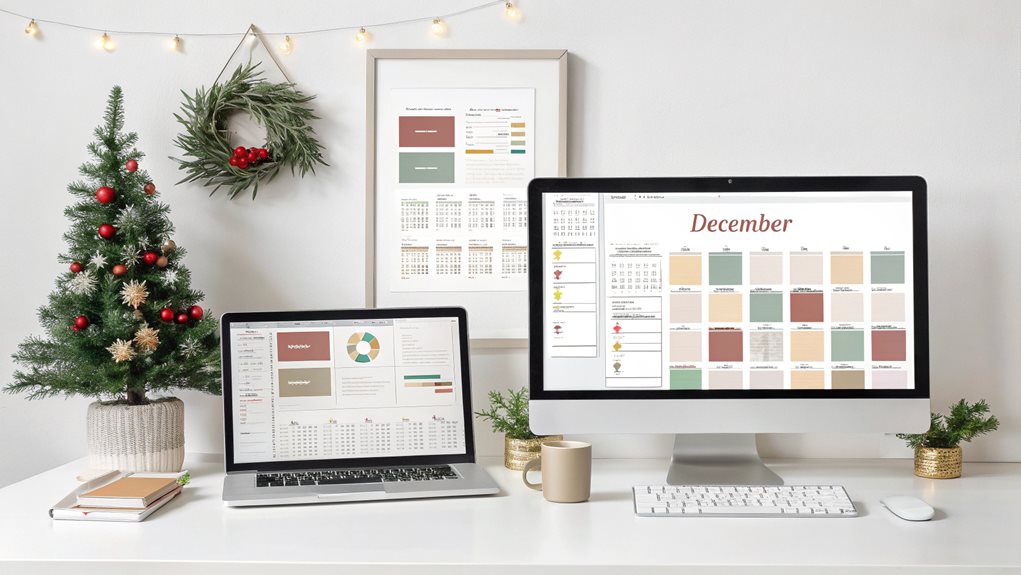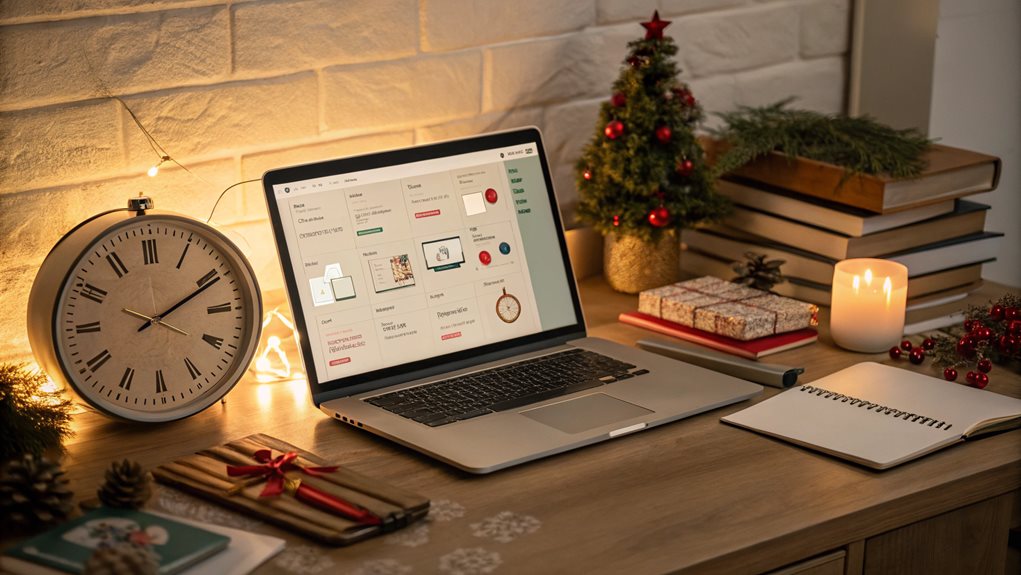
Website Design During the Holiday Rush: Meeting Tight Deadlines Without Sacrificing Quality
To maintain quality during holiday website design rushes, businesses should establish modular design systems with pre-approved seasonal elements and component libraries. Daily client updates and clear expectation documents prevent scope creep, while MoSCoW prioritization focuses efforts on revenue-driving features. Automated testing frameworks reduce manual verification time without compromising integrity. Strategic workload distribution, mandatory breaks, and wellness check-ins help prevent team burnout. Implementing these strategies transforms seasonal pressure into streamlined efficiency that delivers both creativity and conversions.
Expert Highlights
- Implement modular design systems with pre-approved seasonal elements to expedite updates while maintaining brand consistency.
- Establish clear prioritization frameworks using methods like MoSCoW to focus on revenue-driving features first.
- Deploy automated testing frameworks to reduce manual testing time while ensuring quality across critical user journeys.
- Create pre-built templates and component libraries to accelerate development from days to hours during holiday constraints.
- Balance team well-being through strategic workload distribution and focused creative sprints to prevent burnout.
Preparing Your Design Systems for Peak Season Demands

As the holiday season approaches, e-commerce businesses must fortify their design systems to withstand the substantial increase in traffic and user interactions that characterize this critical sales period. Teams face the challenge of maintaining site performance while accommodating seasonal elements and promotional content that customers expect.
The solution lies in creating modular design components that can be quickly implemented without destabilizing the core experience. Businesses should establish a holiday-specific style guide with pre-approved color schemes, typography variations, and responsive promotional modules. This preparation enables designers to implement festive elements efficiently while preserving load times and conversion paths that shoppers rely on. Implementing custom UI/UX design tailored to seasonal user needs ensures your website delivers the perfect balance of festivity and functionality during the busiest retail period of the year.
Time-Saving Templates and Component Libraries

Nearly every e-commerce business faces a critical time constraint during the holiday season, making pre-built templates and component libraries indispensable resources for efficient website updates. When teams access a shared repository of battle-tested design elements, they can implement seasonal promotions, landing pages, and product highlights without starting from scratch.
Component libraries offer modular solutions like holiday-themed headers, promotion banners, and gift guides that maintain brand consistency while accommodating seasonal needs. For peak results, businesses should categorize components by function and complexity, guarantee responsive behavior across devices, and document usage guidelines clearly. This systematic approach reduces development time from days to hours, allowing teams to meet tight deadlines without compromising quality.
Our team combines web design expertise with development capabilities to deliver end-to-end solutions that ensure seamless integration of seasonal elements while maintaining optimal user experience.
Client Communication Strategies During High-Pressure Periods

While templates streamline design workflows, the human side of holiday website preparation demands equal attention. Effective client communication prevents misunderstandings that can derail tight timelines during peak seasons.
| Communication Strategy | Problem Solved | Implementation Tip |
|---|---|---|
| Daily Status Updates | Uncertainty anxiety | Use automated reports |
| Expectation Documents | Scope creep | Create templates beforehand |
| Emergency Protocols | Crisis management | Establish clear escalation paths |
Designers should establish communication boundaries early, setting specific hours for meetings and response times for emails. This prevents midnight revision requests while maintaining client confidence. Creating a shared project dashboard where clients can monitor progress independently reduces the volume of check-in messages without sacrificing transparency. With a 98.5% satisfaction rate, WebLeadsNow’s approach to client communication demonstrates how proper expectation management contributes significantly to successful project delivery even during high-pressure periods.
Prioritization Techniques for Feature Implementation
When holiday deadlines loom, web designers must implement a structured approach to feature prioritization that prevents project derailment. The MoSCoW method—Must-haves, Should-haves, Could-haves, and Won’t-haves—provides a framework that helps teams identify critical functionality while deferring non-essential elements.
Successful designers collaborate with stakeholders to distinguish between revenue-driving features and aesthetic enhancements. For example, ensuring mobile payment processing works flawlessly takes precedence over implementing animated holiday backgrounds. This approach maintains site performance during high-traffic periods while postponing resource-intensive features for post-rush implementation. Teams should document all prioritization decisions in a shared roadmap, allowing everyone to understand the strategic reasoning behind implementation sequencing. Implementing technical SEO elements during the initial development phase can significantly impact site visibility and performance, even while other aesthetic features remain in the pipeline.
Maintaining Creative Quality Under Deadline Constraints
Website teams facing tight holiday deadlines must implement strategies to preserve creative excellence despite time constraints. Focused creative sprints, where designers concentrate on innovation in short, dedicated timeframes, can be paired with template-based approaches that allow for customization while maintaining brand consistency. The most successful holiday campaigns strategically prioritize visual elements with maximum customer impact, such as hero images and call-to-action buttons, ensuring the site delivers both aesthetic appeal and conversion potential even when development time is limited. Incorporating microservices architecture can further enhance website flexibility during the holiday rush by enabling teams to independently develop, deploy, and scale specific site functions without disrupting the entire system.
Focused Creative Sprints
Harnessing the power of focused creative sprints allows design teams to maintain quality standards even during the holiday rush. These time-boxed sessions, typically lasting 2-4 hours, eliminate distractions and channel collective energy toward solving specific design challenges. Many teams struggle with scattered attention and diminishing returns during marathon sessions.
Implementing structured sprints with clear objectives transforms this problem. Teams should schedule sprints during peak energy periods, establish concrete deliverables, and incorporate brief reflection breaks. This approach prevents creative burnout while ensuring consistent progress. The result: higher-quality outputs, stronger team cohesion, and the ability to meet tight seasonal deadlines without sacrificing the craftsmanship clients expect.
Template-Based Innovation
While focused creative sprints optimize team energy, template-based innovation offers a complementary strategy for maintaining design excellence during holiday deadlines. Designers often struggle with balancing originality and efficiency when time constraints tighten during peak seasons.
Pre-built, customizable templates provide the essential framework while allowing for creative adaptation. Teams can develop a seasonal template library with modular components that maintain brand consistency yet permit personalization. This approach reduces production time by 40-60% while preserving design integrity.
The key lies in viewing templates not as creative limitations but as springboards for innovation—allowing designers to focus their creative energy on distinctive elements rather than rebuilding standard structures repeatedly.
Prioritize Visual Impact
How can design teams maintain visual excellence when holiday deadlines compress creative timelines? The pressure to launch seasonal campaigns often forces designers to rush, resulting in compromised visual hierarchy and inconsistent branding.
Successful teams overcome this challenge by creating pre-approved visual libraries containing seasonal assets, color palettes, and typography combinations. These curated elements allow designers to assemble high-impact visuals quickly without starting from scratch. Additionally, establishing a clear prioritization framework helps teams focus on high-visibility elements first—hero images, call-to-action buttons, and promotional banners—ensuring the most important touchpoints receive appropriate creative attention despite tight deadlines.
Testing Shortcuts That Don’t Compromise Site Integrity
When facing the holiday rush, website designers can implement several testing shortcuts without sacrificing site integrity. Automated testing frameworks greatly reduce manual testing time while maintaining extensive coverage of vital functionalities, allowing teams to focus on high-impact areas. Vital path prioritization guarantees essential user journeys—such as checkout processes and product searches—receive thorough testing while less important elements undergo streamlined verification, complemented by accelerated QA cycles that compress standard testing protocols into efficient sprints with clearly defined acceptance criteria. Implementing a strategic multi-channel approach similar to effective lead generation campaigns can enhance website performance verification across different user devices and platforms.
Automated Testing Frameworks
During the holiday rush, website testing can easily become a casualty of tight deadlines, yet automated testing frameworks offer essential shortcuts without sacrificing site integrity. These frameworks enable teams to validate critical functionalities while maintaining quality standards that customers expect.
| Framework Type | Benefits | Best Use Cases |
|---|---|---|
| Unit Testing | Catches code-level bugs early | Component validation |
| Integration | Guarantees systems work together | API connections |
| End-to-End | Validates complete user flows | Checkout processes |
Critical Path Prioritization
While automated frameworks handle repetitive test scenarios efficiently, the holiday rush demands an even more strategic approach to testing. Critical path prioritization focuses on identifying and testing the most essential user journeys—like checkout processes and payment gateways—that directly impact revenue.
Development teams should map customer flows, rank features by business impact, and establish testing tiers. Tier 1 paths receive thorough testing, while secondary features undergo abbreviated tests. This targeted approach guarantees core functionality remains flawless even under tight deadlines.
Accelerated QA Cycles
As holiday deadlines loom ever closer, development teams must implement accelerated QA cycles without sacrificing website integrity. The challenge lies in maintaining detail while reducing testing time. Teams can adopt automated regression testing focusing on critical user flows—checkout processes, product searches, and payment systems—rather than thorough testing of every feature.
Implementing parallel testing environments allows multiple testers to work simultaneously across different components. Prioritized bug fixes based on user impact guarantee that show-stopping issues are addressed first, while minor visual glitches can wait. Cross-functional testing teams, where developers and designers participate in QA sessions, catch issues earlier and reduce revision cycles considerably.
Self-Care and Team Management During Crunch Time
The holiday season brings not only increased client demands but also heightened stress levels for web design teams facing tight deadlines and complex projects. Team leaders must recognize early warning signs of burnout, including decreased productivity, irritability, and declining work quality.
Effective management during crunch periods involves strategic workload distribution, mandatory breaks, and clear communication channels. Successful design teams implement wellness check-ins, establish reasonable boundaries with clients, and celebrate small victories. Creating dedicated quiet spaces, encouraging physical activity between coding sessions, and permitting flexible schedules prevents creative exhaustion while maintaining productivity.
Remember: sustainable pace equals sustainable quality, even amid holiday deadlines.
Frequently Asked Questions
How Much Should I Charge for Rush Holiday Website Projects?
Professionals typically charge 25-50% premium for rush holiday website projects. Rates vary based on complexity, timeline constraints, and market position. Many designers offer tiered pricing reflecting urgency levels.
What Are the Most Effective Holiday-Specific Website Analytics to Track?
Essential holiday website analytics include conversion rates, traffic sources, campaign performance, cart abandonment rates, site speed metrics, gift guide interactions, mobile usage patterns, and peak shopping hour activity.
When Should I Start Preparing for Next Year’s Holiday Season?
Preparations should commence 6-8 months before the holiday season. Smart designers evaluate previous performance in January, map strategies by spring, and begin implementation by summer to avoid last-minute pressures.
How Do Holiday Website Design Trends Differ Across Global Markets?
Holiday website design trends reflect cultural celebrations, with variations in color schemes, symbolism, and seasonal imagery across regions. Western markets favor red-green aesthetics while Asian markets often prioritize different festive colors and symbols.
Should I Use Specialized Hosting Solutions During High-Traffic Holiday Periods?
Specialized hosting solutions are highly recommended during peak holiday periods. They provide essential scalability, preventing costly downtime when traffic surges, ensuring everyone in the community experiences seamless shopping interactions.
Expert Final Thoughts
Successfully maneuvering the holiday rush requires designers to balance speed with quality through strategic preparation. By implementing streamlined workflows, leveraging templates, maintaining clear client communication, and prioritizing essential features, teams can meet tight deadlines without compromising website integrity. Regular testing and team well-being remain vital throughout. With the right systems and mindset, designers can transform seasonal pressure into exceptional digital experiences that satisfy both business goals and user expectations.